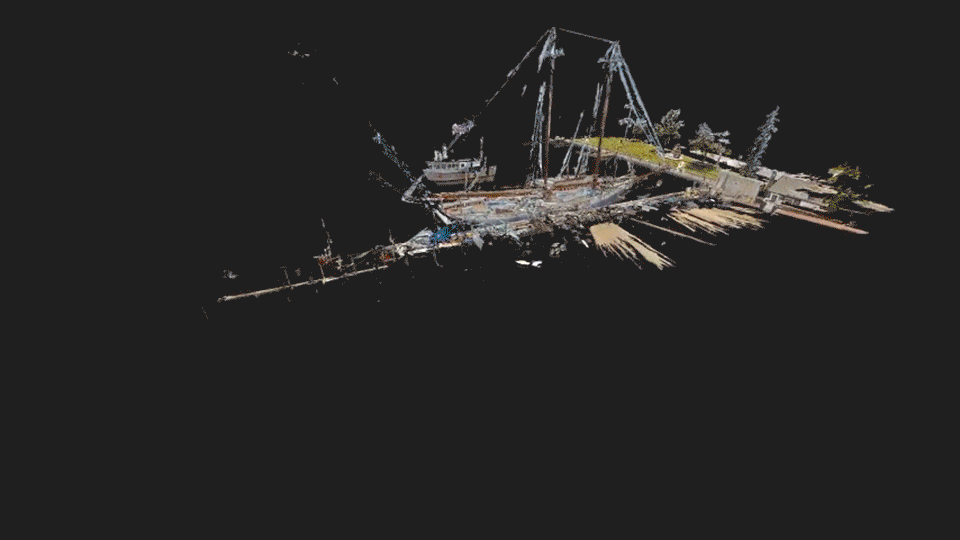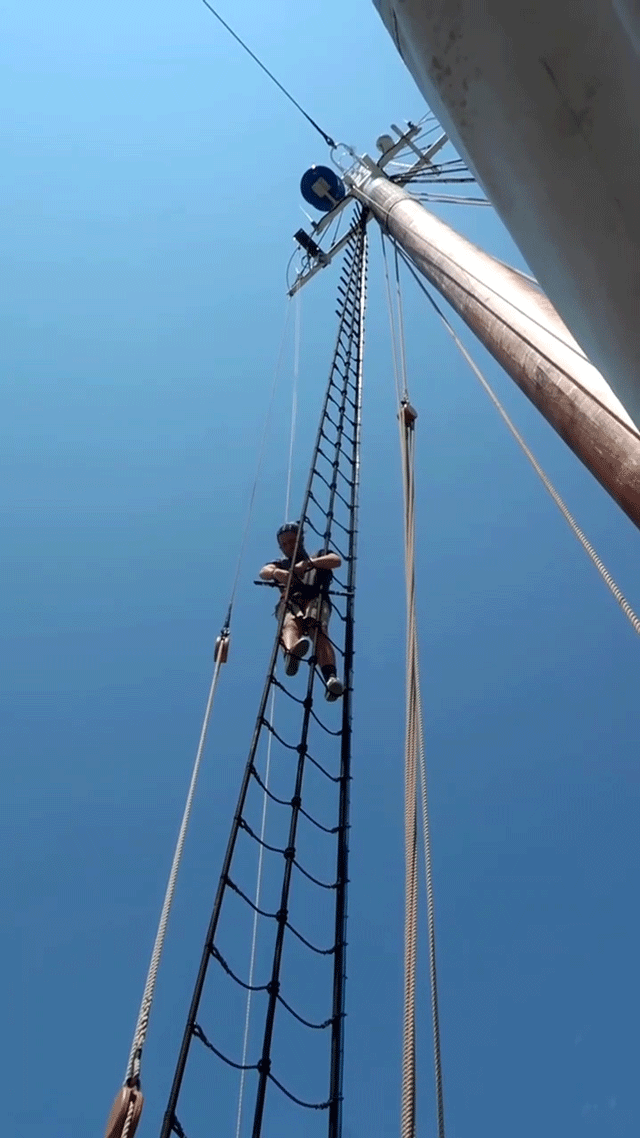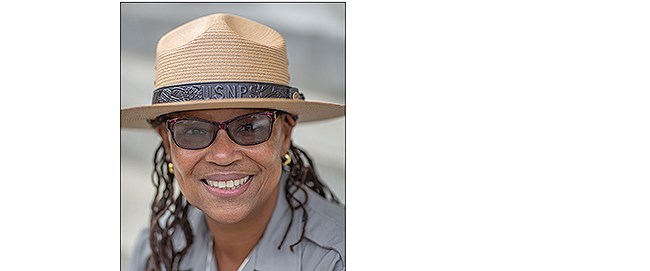Last updated: March 7, 2025
Article
How a 3D Virtual Tour Shared a Beloved Ship’s Story with the World
In its latest of many lives, the Schooner Ernestina-Morrissey is often at sea, unavailable to park visitors. We recreated it virtually so more people than ever can explore its decks—and its stories.

Image credit: NPS
Some of the more fascinating parts of our shared cultural heritage don’t stay put.
Built in 1894, the Schooner Ernestina-Morrissey currently spends about six months a year berthed in New Bedford, Massachusetts. It's one of the features of New Bedford Whaling National Historical Park and a draw for many visitors. But the ship is also an active teaching and training vessel and a member of the Massachusetts Maritime Academy fleet, so it’s not always available for in-person tours. Using 360-degree (360°) imaging technology, we created a three-dimensional, virtual tour of the much-loved ship, enabling 24-7, year-round, internet access to this important piece of maritime history.
Established in 1996, New Bedford Whaling National Historical Park occupies 34 acres in an urban environment. This national park preserves, protects, and shares information about the history of the American whaling industry. The park also preserves stories of global immigration, the Underground Railroad, women’s history, architecture, and art. Through my work, I (da Silva) look for different ways to tell the park’s exciting stories. I’d heard that the National Center for Preservation Technology was creating virtual tours of textile mills in Blackstone River Valley National Historical Park. I reached out to Catherine Cooper at the center to see if something similar could be done for the Ernestina-Morrissey.
I (Cooper) have been working with the center’s Technical Services team to creatively apply 360° imaging technology to expand the accessibility and interpretation of cultural sites. We were making virtual, child-height tours of the textile mills at Blackstone River when da Silva contacted me. The timing for her project was right: the Ernestina-Morrissey had just undergone extensive renovation and would soon be returning to port. I went to New Bedford to collect data for the virtual tour.
Ernestina-Morrissey—the Phoenix Ship
Like the mythological bird, the phoenix, the Ernestina-Morrisey has lived many lives and served many purposes. Its first life began on February 1, 1894, when it left the shipyard in Essex, Massachusetts, as the Effie M. Morrisey. The ship was named after Captain William E. Morrissey’s daughter and served as a fishing vessel up and down the east coast of North America. Between 1894 and 1914, the ship made berth in Massachusetts and in Nova Scotia and Newfoundland, Canada, under different captains. It’s one of only a handful of remaining fishing schooners that exemplify the early history of the fishing industry on the east coast of North America. New Bedford, where the ship now lives, has been the largest fishing port in the northeastern United States for more than 20 years.
The Morrissey entered a second life when Captain Robert “Bob” Bartlett bought the ship from his cousin, Harold Bartlett, in 1924. Bob Bartlett was an arctic explorer who took students and scientists north on the Morrissey from 1926 to 1946. It was during this life that the Morrissey was outfitted with its first engine and tough 1.5-inch greenheart (a water-resistant Central American hardwood known for its strength) sheathing to protect the hull from ice. From 1942 to 1945, during the Second World War, the ship transported supplies to arctic base camps. Former crew members, scientists, and students who sailed with Bartlett remain deeply connected to the Morrissey.
A fire broke out in the galley, and the New York City Fire Department sank the ship in the harbor to put out the flames.
In 1946, after Bartlett’s death, two brothers, Melvin and Sidney Jackson, bought the Morrissey. They started the Coastal Carrier Corporation, intending to use the ship for trade in the South Pacific. But this was a short and almost life-ending interlude for the vessel, as the brothers soon deemed the Morrissey unseaworthy and docked it in Flushing, New York. A fire broke out in the galley, and the New York City Fire Department sank the ship in the harbor to put out the flames. The brothers raised the ship shortly thereafter, towed it to Connecticut, and put it up for sale.
Henrique Mendes, a Cape Verdean ship captain, and his family bought the Effie M. Morrissey in 1947. They had the vessel towed to New Bedford and began repairs. During the renovation, the Mendes family removed the engine, drive shaft, and propeller to prepare the ship for its fourth life as a packet—cargo and passenger—vessel. In 1949, Henrique Mendes changed the name of the ship to Ernestina, after his daughter, and registered the vessel in Cape Verde, an island country 385 miles off the west coast of Africa. The Ernestina carried cargo and immigrants between America and the Cape Verde Islands from 1948 to 1965.
In 1977, Cape Verde gifted the Ernestina to “the people of the United States” to be delivered to the State of Massachusetts.
During the 19th century, men from the Cape Verde Islands often joined the crews of whaling ships when the ships stopped in port to seek supplies and new personnel. By the end of the whaling era in 1925, Cape Verdean women and children also emigrated to the United States, often landing in New Bedford. Emigration from Cape Verde moved from whaling ships to packet vessels like the Ernestina throughout the 20th century. The schooner continues to symbolize the legacy of the Cape Verdean-American community and is frequently included in community events.
Ownership of the vessel passed from Mendes to his son-in-law, Luiz Silva Randall, governor of Cape Verde, in 1963, then through several hands until the government of Cape Verde acquired it. In 1977, Cape Verde gifted the Ernestina to “the people of the United States” to be delivered to the State of Massachusetts. It took years of fundraising and repairs to prepare the ship for another trans-Atlantic crossing, but the Ernestina returned to the United States on August 30, 1982.

Image credit: Schooner Ernestina-Morrissey Association
The U.S. Department of the Interior granted the Ernestina national landmark status in 1990, and the ship began its fifth life—as a living history museum and educational vessel. The Massachusetts State Legislature designated the ship as the official vessel of the Commonwealth of Massachusetts in 1994, establishing the Schooner Ernestina Commission. Congress added the ship to New Bedford Whaling National Historical Park's enabling legislation when it established the park in 1996. In 2014, the Schooner Ernestina Commission of the Commonwealth of Massachusetts changed the ship’s official name to Ernestina-Morrissey, encompassing its whole history.
"This is the start of a really great next chapter."
But the commission struggled for many years to keep the ship maintained and Coast Guard certified, so in 2019, the Ernestina-Morrissey began its sixth life when Massachusetts State, together with the commission, transferred stewardship of the vessel to the Massachusetts Maritime Academy. The ship went to Boothbay Harbor, Maine, for a complete restoration, returning to the water again in late 2022. Then it began participating in national sailing events, including the 2023 Gulf Coast Tall Ships Challenge. The Massachusetts Maritime Academy is working toward dual Coast Guard certification for the ship in order to take school groups and educators out to sea.
“This is the start of a really great next chapter,” said the vessel’s captain, Tiffany Krihwan. “And I think it's going to be a nice long chapter working with the cadets at the academy…doing outreach for [school] programs on all different aspects of marine science, cultural awareness, oceanography, history, living history, sea history, nautical sciences.” Krihwan said the ship will still go to tall ship events “so that people can come and see her, tour on board.”
Creating a Digital Twin and Avoiding Ghosts
When I (Cooper) arrived in New Bedford in July 2023, it was warm and sunny with a breeze blowing in off the ocean, perfect weather for working onboard the Ernestina-Morrissey. Da Silva and I walked down from park headquarters to where the ship was docked and spoke to Captain Krihwan and the crew about the scope of our project. With 360° imaging, everything the camera sees gets included in the model. But the Ernestina-Morrissey is not just a sailing vessel; it’s home to the crew. So we also talked about how to maintain crew privacy while photographing the ship.
I could only take three to five steps when moving the tripod between images.
The 360° images can be stitched together to create a virtual, three-dimensional representation of a physical space—a ship in this case. These sorts of virtual spaces can be created using a variety of cameras, from cell phones and tablets to specialized 360° cameras. I used two cameras for this project—a Matterport Pro3 and a Ricoh Theta, both of which I controlled through an iPad. The Matterport Pro3 sits on a tripod. When in use, it automatically rotates on the tripod to collect a series of images, then stitches them into a 360° view from that location. The Theta camera has two wide angle lenses and takes a single 360° image from each location.

Image credit: NPS / Catherine Cooper
The platform we chose to use for this project was Matterport, which auto-stitches the images together to create a digital twin. As I moved the camera from one location to another, the individual 360° images began to build out the space. I could only take three to five steps when moving the tripod between images, because the software needs each image to overlap with the previous image.
It’s easiest to build out a virtual space by starting in a location that has walls. This lets the program find the edges and boundaries of the model. Doors also need to be open so that the camera can see from one compartment into another. I started by taking images with the Matterport Pro3 below deck in the ship’s galley. For spaces such as the “heads” (bathrooms), I would leave the door closed until I moved the camera a few steps away from the doorway. This would give viewers the option to go inside or continue into another room. I took additional scans to show normally hidden things, such as inside closed storage compartments. This would help viewers understand how the crew uses the space.
To avoid being in the model, we had to remember that if you can see the camera, it can see you.
While photographing inside the Ernestina-Morrissey, the crew and I needed to hide from the camera, otherwise we would become “ghosts” in the virtual tour. To avoid being in the model, we had to remember that if you can see the camera—even in a mirror or through a window—it can see you. Below deck, hiding from the camera was as easy as being in another room. On deck, I had to climb up and down ladders or crouch behind objects to avoid being caught in the picture.

Image credit: NPS
To connect the decks of the ship to one another, I set up the tripod to take images on slanted ladders every few steps. I worked with Brooke Foran, a deckhand on the Ernestina-Morrissey, to get down into some of the small compartments that had completely vertical ladders. She and I passed the camera to each other up or down the steps and adjusted the height of the tripod to the height of each step. At one point, Foran had to get out of the image by crawling through a port hole into the galley.
We took and stitched together 158 360° images to create the virtual tour of the ship.
We also took images aloft, in the elevated areas of the ship such as the masts and rigging. For this, we used the Rioch Theta camera, which is about the size of a glasses case and can be mounted on a selfie stick. Spencer “Donny” Donahower, a deckhand trained to use harness and safety line, took the Theta up both masts. In total, we took and stitched together 158 360° images to create the virtual tour of the ship.

Image credit: NPS / Catherine Cooper

Image credit: NPS / Catherine Cooper
Collecting Stories
Taking images of the ship and dock took up most of two days. I dedicated my remaining time to interviewing the ship’s current crew and recording our conversations. I asked each individual how they came to be a member of the crew and if they had a favorite story about their shipboard experience to relate. They told me about the ship’s history, the intricacies of sailing, the recent restoration, and the ship’s continuing legacy. Viewers will hear the sounds of ship life in the background of many of our conversations.
We heard many stories from people who had family ties to the vessel.
I (da Silva) interviewed community members after Cooper returned to the National Center for Preservation Technology. I interviewed members of the commission and of the Schooner Ernestina-Morrissey Association over Teams video calls. These conversations dug into the ship’s history and its importance to both the United States and Cape Verde. I asked each interviewee three questions:
-
What’s your history with the Ernestina-Morrissey?
-
What’s your current relationship with the ship?
-
What do you see in the ship’s future?
We heard many stories from people who had family ties to the vessel. They shared the experience of sailing on the Ernestina-Morrissey and how the ship came back to the United States from Cabo Verde. We also dove into historic materials, finding photographs, early film footage, and news broadcasts. Much of the information was already digitized and available on the association’s website or in the archives at the University of Massachusetts, Dartmouth.
Building the Tour
The 360° imaging platform we used is continually updating its features and has many tools. One tool we use is a “tag”—a pin that we can add to a specific location within the tour that gives additional information. Each tag has a title and contains space for a description, keywords, and photos, audio, or videos that can be viewed inside the tour. In the Ernestina-Morrissey tour, the tags have icons: a camera for photos, a microphone for audio interviews, a video camera for videos, and chain links to denote navigation hyperlinks.
We added the interviews with crew and community members to the Ernestina-Morrissey virtual tour as videos. This makes it possible to listen to the conversations without leaving the model or downloading an audio file. For full accessibility, we transcribed all interviews so the conversations could be read as well as heard.
A Bright Future
The Schooner Ernestina-Morrissey is well on its way to an incredibly active sixth life. When the Massachusetts Maritime Academy took over stewardship of the vessel, they agreed to berth Ernestina-Morrissey in New Bedford for several months each year so the local community can interact with it. New Bedford Whaling National Historical Park expects to help out with this, providing visitors with educational opportunities to learn about the vessel and walk through it. Although more people will be able to sail onboard once the ship is certified, many will never get the chance to see it in person. The virtual tour will create a stable, accessible portal for those visitors to view the ship.
“The…360 technology allows us to engage with a much wider audience, attracting new stewards and supporters of the mighty Schooner Ernestina-Morrissey,” said the park’s superintendent, Jennifer Smith. “History lovers, tech geeks, and maritime enthusiasts will all find meaningful connections through the story and visuals captured and knitted together in this accessible virtual tour.” Smith said this technology “allows the park to carry out the intent of [its] legislation.”
The virtual world is the Ernestina-Morrissey’s most recent expedition, but it won’t be its last.
“One of the things about Ernestina-Morrissey is that she has always crossed boundaries,” said Laura Pires-Hester, PhD, a former chair of the Schooner Ernestina-Morrissey Commission and Cape Verdean historian and anthropologist. “She has always been open to all people, all cultures, and that's something that I'm hopeful will continue in her future.”
The tour is complete for now, but as more stories come to light or events happen, we can add information to the ship’s digital space. The virtual world is the Ernestina-Morrissey’s most recent expedition, but it won’t be its last.
About the authors

Catherine G. Cooper, PhD, is a research scientist in the Technical Services division of the National Center for Preservation Technology and Training. Image credit: NPS.

Tags
- new bedford whaling national historical park
- ernestina-morrissey
- schooner
- sailing ships
- whaling history
- exploration
- cape verde
- virtual tours
- full 360
- accessibility
- storytelling
- virtual experience
- catherine cooper
- janine v. da silva
- women in science and technology
- cultural heritage
- technology
- methods
- features
- ps v38 n1
- park science magazine
- park science journal

